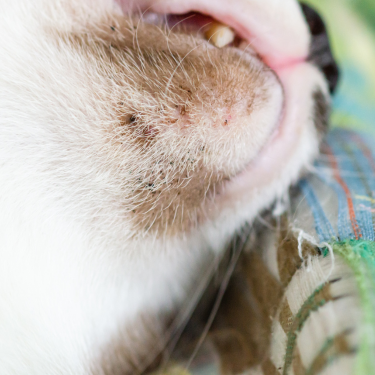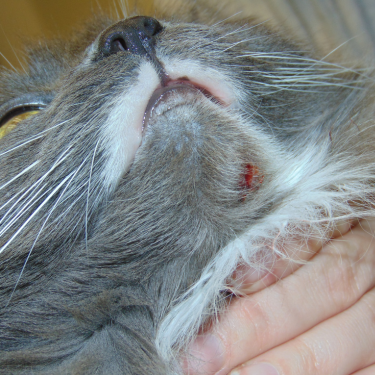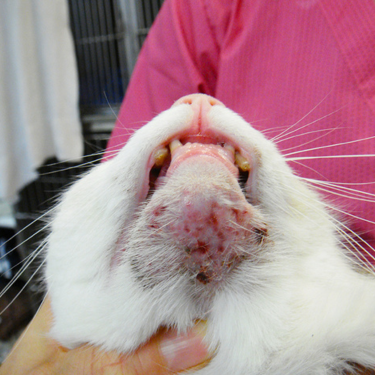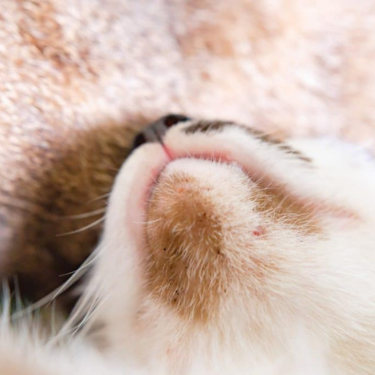How to Treat Cat Acne.
Cat acne, or feline acne, is a common skin condition that can affect your cat's chin and cause discomfort. Learning how to treat and manage cat acne is essential for keeping your feline friend’s skin healthy. In this guide, we'll delve into the causes of chin acne, provide practical treatment options, and share tips for preventing future breakouts, ensuring your cat’s skin remains clear and comfortable.
Cats can develop acne just like humans. If you begin to notice persistent pimples that don’t seem to clear up, here's what you should know.
Unfortunately, acne isn’t a problem reserved for humans cats can also suffer from it, often referred to as feline acne. This skin condition, which commonly affects the chin area, can be caused by various factors such as hair follicle issues or sebaceous gland problems. Although the exact cause of cat acne is not always clear, it can lead to clinical signs like black spots, inflammation, and hair loss.

In severe cases, the affected area may develop secondary infections, including bacterial or fungal infections. Factors such as plastic food dishes or poor hygiene can contribute to the development of chin acne in cats. Owners should be aware that this condition can manifest as both mild and severe cases, with some instances responding slowly to treatment.
To address feline acne, it's important to consider using topical treatments like benzoyl peroxide and ensuring proper hygiene. Stainless steel food dishes are recommended to reduce the risk of acne. If you notice signs like a rub chin or changes in the cat's skin condition, consulting a veterinarian for an appropriate treatment plan is essential. This may involve topical medication to manage inflammation and prevent further issues. Always review your cat's medical history and consult with your vet to determine the best course of action for treating this common condition.

Why are there black scabs on cat's chin?
If you notice sores or black spots on your cat's chin, it could indicate chin acne or a related skin issue. Cat acne commonly appears on the chin, but it can also affect the lip margin. Inflammation and scabs in these areas might suggest a bacterial infection or other causes of feline acne. If you see these signs or observe your cat rubbing its chin, consult a vet for an appropriate treatment plan. Whether it's a mild case or more severe, addressing the condition promptly is crucial for effective treatment.
What is cat acne?
Cat acne, also known as follicular keratinization, arises when hair follicles become blocked due to excessive production of keratin, a protein in the skin. This condition commonly affects the chin area and is often referred to as chin acne. In cats, acne can also appear on the lip margin and may lead to inflammation and spots. If you see acne on your cat’s chin or notice your cat rubbing its chin, it could be a sign of a bacterial infection or other skin issues. Addressing this common condition early with appropriate treatment is crucial, whether it’s a mild case or more severe.
What does feline acne look like?
Cat acne often presents as small bumps with blackheads or whiteheads, similar to human acne. However, on a cat’s chin, it may look more like dirt than actual pimples, which can make it hard to spot. This common condition can also affect the chin lip area. In severe cases, inflammation can lead to hair loss, redness, and even bleeding. Early treatment is crucial to manage the symptoms and prevent further issues.

What causes cat acne?
The exact causes of cat chin acne remain largely unknown, but it is believed to be linked to excessive keratin production. However, certain lifestyle factors can also contribute to the development of cat chin acne:
Plastic Bowls
Cats that use plastic bowls for food and water are more likely to develop acne.
Poor Grooming
Inadequate grooming, particularly in older cats, can exacerbate the condition.
These causes of cat acne, including chin acne, can often be managed relatively easily. However, there are several underlying conditions that may also contribute to the development of chin acne:
- Weakened immune system
- Stress
- Food allergies
- Hormonal imbalances
- Overactive sebaceous glands
If you’ve made the necessary lifestyle changes and still suspect that your cat’s chin acne or other cat acne issues might be caused by an underlying problem, you should contact a veterinarian.

How is cat acne diagnosed by a vet?
When diagnosing cat acne, including chin acne or issues affecting the chin lip, your vet might take blood samples, perform a skin cytology to check for abnormal cells or bacteria, and collect a urine sample. If there are unusual lesions, a biopsy may be performed and/or dental X-rays might be used to rule out cancer or tooth infections. These tests help identify underlying causes and guide effective treatment for inflammation and other symptoms associated with cat acne.
How to treat feline acne – 10 approaches to consider
While chin acne in cats often clears up on its own, treatment may be necessary if breakouts are frequent or if the condition becomes severe.
It’s important to consult your vet before starting any treatment, as human acne products can be too harsh for a cat's skin. If you notice cat acne affecting the chin lip or see inflammation on the chin, here are some common solutions for treating cat acne:
Steroid Injections
In severe cases of cat acne, a vet may prescribe steroids to help manage inflammation.
Topical Antibiotics
For cat acne, antibiotics applied as a cream or gel directly to the affected area can also be an effective treatment.
Systemic Antibiotics
In severe cases of cat acne where an infection has developed, the vet may recommend a course of antibiotics.
Ointments & Creams
Applying an antimicrobial gel several times a day can also help clear up cat acne.
Medicated Cat Shampoos
Mild cases of cat acne can be treated with antiseborrheic shampoo. For more specific needs, your vet may recommend antibacterial or antifungal shampoos. While it might be tempting to use human anti acne products for cat acne, only do so if directed by your vet.
Replacing Plastic Bowls
Consider using stainless steel or ceramic bowls for your cat’s food and water to help prevent cat acne.
Omega-3
Fatty acids, such as Omega-3, can support skin health and are often recommended for cats prone to cat acne breakouts.
Warm Compresses
Warm compresses can help alleviate mild cat acne and reduce swelling.
Cleaning the area
Chlorhexidine antibacterial washes can be used to clean the area affected by cat acne. Apply the treatment a couple of times a day until the acne starts to improve.
Consult a Vet for Severe Cases
For persistent or severe cases of chin acne or cat acne, seek veterinary advice to determine if additional treatment or a biopsy is necessary.

FAQ
1. Can cat acne be contagious?
No, cat acne is not contagious. It’s a condition that affects individual cats and is not spread through contact with other animals.
2. Are certain cats more prone to acne?
Yes, cats with poor grooming habits, those that use plastic bowls, or older cats are more prone to developing cat acne.
3. Can human acne products be used for cat acne?
No, human acne products can be too harsh for a cat’s skin. Always use treatments specifically designed for cat acne and follow your vet’s advice.
4. When should I consult a veterinarian for cat acne?
Consult a vet if the cat acne is persistent, severe, or accompanied by signs of infection or other health issues.
5. Can cat acne lead to hair loss?
Yes, severe cases of cat acne can lead to hair loss in the affected areas.
6. Can cat acne be a sign of an underlying health problem?
Yes, persistent or severe cat acne can sometimes indicate underlying issues like hormonal imbalances or immune system problems.
7. How can warm compresses help with cat acne?
Warm compresses can reduce swelling and discomfort in mild cases of cat acne.
8. Is it necessary to biopsy a cat with acne?
A biopsy may be necessary if the cat acne looks unusual or doesn’t respond to standard treatments, to rule out other conditions.
9. How long does it typically take for cat acne to resolve?
Mild cases of cat acne may resolve within a few weeks with proper care, but severe cases may take longer and require veterinary treatment.
10. What are the benefits of using stainless steel bowls for cats?
Stainless steel bowls are less likely to harbor bacteria compared to plastic, reducing the risk of cat acne and other skin issues.

















